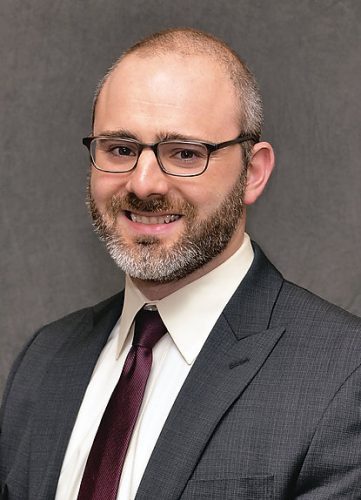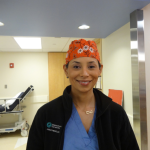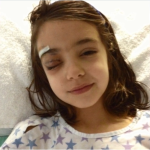A question often on the minds of parents in a baby’s first weeks and months of life is, “what can my baby actually see?” While hearing is fully developed at birth, vision actually takes some time to mature. Focus spoke with Eric D. Gaier, MD, PhD, a member of the Pediatric Ophthalmology and Strabismus Service at Mass Eye and Ear, and a neuro-ophthalmologist and neuroscientist at Boston Children’s Hospital, to answer our burning questions about what babies see.
-
What should a baby typically see at birth?
Vision in a newborn is far from fully developed at birth. In fact, development of the retina, the light-sensing tissue in the back of the eye, is ongoing within the first weeks and months of life. Changes in the shape and size of the eye that affect a baby’s ability to focus occur from birth to two years old. What is also important is that the neural connections between the eye and along the visual pathway within the brain form over the first several years of life.

The vision of newborn babies is typically around the 20/600 level on average, which allows them to make out the major features of their parents’ faces when being held or face-to-face. Newborns can also see high-contrast (for example, black and white) and bright, shiny objects best during those early weeks.
-
What distance can a newborn see?
For anyone’s vision, regardless of age, the shape and size of the eye is what determines whether images near or far are in focus. Since newborns’ eyes are smaller, they tend to be farsighted, meaning objects at a distance are in relatively better focus. That said, because of the complexity of our visual world and how low a baby’s visual resolution is at this stage, a newborn tends to respond best to high-contrast objects or images presented at relatively shorter distances.
-
How does a child’s vision progress within his or her first year of life?
Within the first six months of life, a baby’s ability to see improves from about the 20/600 level to the 20/80 level on average, which is remarkable. This improvement is primarily a result of the development of the retina and visual pathways in the brain.
During this time, there are advances in babies’ control of eye movement, stability and alignment. Much like how babies learn to coordinate movement of their bodies, they also learn how to coordinate their eyes to interact with their new world by directing gaze toward objects of interest like a caregiver or toy.
The visual parts of the brain that process information coming from the eye continue to undergo dramatic changes throughout the first few years of life. Typically, vision does not reach its peak until around five years of age.
There is a smartphone application called “BabySee” through which parents can get a sense of how the world appears to their baby at different stages of development. The app was developed by the ophthalmologist-in-chief at Boston Children’s Hospital, Dr. David Hunter, in conjunction with a company called Rebion, Inc.*

-
When should my baby have his or her first vision test?
Not all children need to have a routine eye exam performed by a pediatric ophthalmologist, but the importance of vision screening in young children by their pediatricians cannot be understated. Between ages one to three, the child’s pediatrician looks for any potential problems with vision, but this can vary depending on the scope of the practice and equipment available.
Normal development of our visual systems during infancy and early childhood can be derailed for several reasons, including an unrecognized need for glasses, eye misalignment or blockade of vision by a cataract. The earlier these problems are recognized and treated, the better the visual outcomes are for children throughout their adult lives.
-
What does a baby’s vision test entail?
Our ability to test vision in very young children is of course limited by their ability to tell us what they see.
Vision screening by a pediatrician is primarily focused on identifying risk factors for visual problems, such as eye misalignment or a need for glasses. Pediatricians can often identify significant eye misalignments, but hand-held “vision screeners” are used to detect the need for glasses. Pediatricians will refer children to a pediatric ophthalmologist if there are any concerns based on their examination or testing. Visual problems tend to run in families.
Therefore, making an appointment to see a pediatric ophthalmologist is a good idea if there are family members who experienced any eye conditions during childhood, even in the absence of screening findings by the pediatrician.
-
What are some early signs of poor vision in children?
If an infant has poor vision, it can be recognized as early as six to eight weeks after birth when we would expect babies to start exhibiting behaviors that depend on vision. Normal visual behaviors at this age include maintaining eye contact, returning a smile to their parents, and following a shiny toy with their eyes. Absence of these behaviors at the expected age may signify a visual problem. Some children with significant visual impairment can exhibit abnormal eye movements that resemble shaking of the eyes, called nystagmus, or eye misalignment such as eye crossing or wandering.
Older infants with visual difficulty or eye misalignment may tilt or turn their heads when viewing. They may also hold objects very close to their face to examine them. These signs are usually recognized by parents and brought to the attention of the pediatrician. Any of these concerning visual behaviors warrants a complete eye examination by a pediatric ophthalmologist.
-
Can poor vision affect my child’s development?
Vision, like other sensory systems such as hearing and touch, requires experience early in life to facilitate development. During this critical time, disruptions in visual experience can impart life-long consequences in visual processing in the brain that affect visual function. Unfortunately, this critical period is also the time when reversal of these setbacks are best made with treatment. Therefore, early recognition and intervention of visual problems in children is imperative.
Vision is such an important part of the human experience, it’s no wonder that more than one-third of the human brain is related to vision. The visual system serves as one of the best models to understand how experience shapes the human brain, a major research focus of mine. Deepening this understanding ultimately expands our ability to help patients with many sensory and developmental problems.
*Dr. Gaier is a provider at Boston Children’s Hospital, but has no financial disclosures or involvement with the app.
About Our Expert
 Dr. Eric D. Gaier is a member of the Pediatric Ophthalmology and Strabismus Service at Mass Eye and Ear, who specializes in neuro-ophthalmology and sees patients at the Main Campus, and at Boston Children’s Hospital at Waltham.
Dr. Eric D. Gaier is a member of the Pediatric Ophthalmology and Strabismus Service at Mass Eye and Ear, who specializes in neuro-ophthalmology and sees patients at the Main Campus, and at Boston Children’s Hospital at Waltham.



